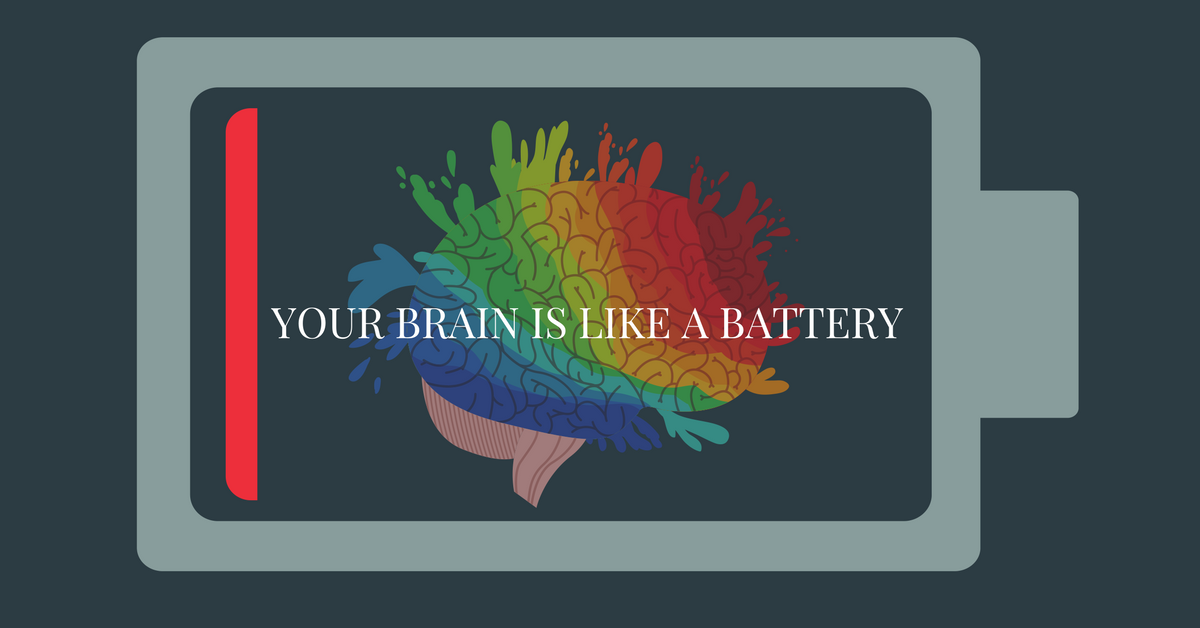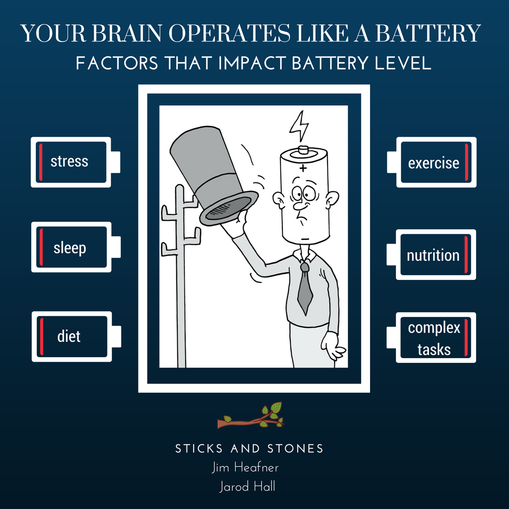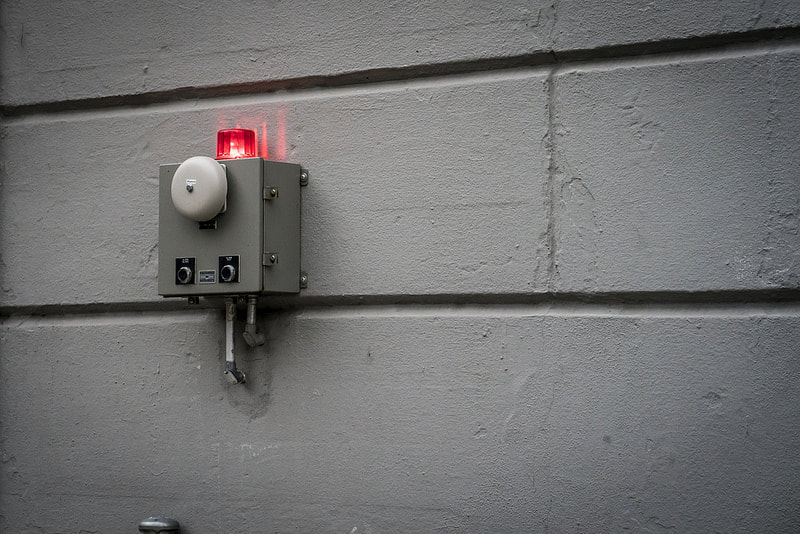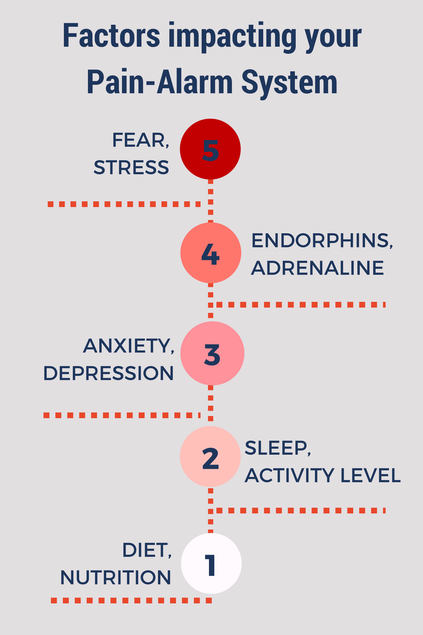|
I was recently working with someone who had neck pain after a mountain biking accident. During the evaluation, he reported hitting his head on the ground and experiencing a concussion during the accident. He stated "I am having difficulty remembering recent events and multi-tasking is near impossible! It's extremely frustrating!." Performing higher level tasks was easier in the morning and became progressively more challenging throughout each day. Additionally, he reported the desire to take naps throughout the day. When he questioned why his brain felt exhausted, I told him "It is because your brain operates much like a battery." (This text is adapted from "Sticks & Stones," a book by Jarod Hall PT, DPT, OCS and Jim Heafner PT, DPT, OCS. "Sticks and Stones" is in the final stages of development. Final versions of the text to be released to public in May 2018. Please reach out if you are interested in learning more information!) If you have persistent pain, recently had a surgery, or an injury (such as a concussion), your brain may be working in overdrive! In each of these scenarios it's not uncommon for patients to report that their brains feel tired early in the day, that they have trouble doing complex thinking tasks such as math, and even mix up their left from their right! Why does this happen? In situations like this you can liken your brain to a battery. This idea can be thought of in two separate ways. 1) You start each day at 100%, but quickly drain the battery each day |
| Like this post? Check out how Pain is like an Alarm System! |
7 Comments
Most people think pain is an indicator of the amount of tissue damage present in the body. The belief is that high amounts of pain equate to a large injury, and a small amount of pain equates to a small injury. However, through extensive research, it has been shown that pain has little correlation to the amount of tissue damage. For example, a paper cut may cause intense pain, while a broken bone may go unnoticed. In 2013, when Louisville basketball player Kevin Ware sustained a horrific leg fracture, he reported, "it was one of those things where I couldn't believe it. I honestly didn't feel the pain. It was more a shock."
"At the center of the alarm system is your brain, which beeps when it THINKS something is going wrong or is potentially dangerous."
Kevin Ware’s story perfectly demonstrates that pain is more like an alarm system. It is an evolutionary provided and naturally built system designed to keep you out of danger. At the center of the alarm system is your brain, which beeps when it THINKS something is going wrong or is potentially dangerous. If the system is healthy, it warns you when something is wrong just as your home alarm rings when a burglar breaks a window or your car alarm sounds if a car thief tries to wiggle your door open.
"Just as a smoke detector can be set off in the absence of fire, a home alarm in the absence of a burglary, and a car alarm when you accidently press the panic button, your body’s alarm system sounds off signals of pain in the absence of any REAL danger or threat."
However, just as a smoke detector can be set off in the absence of fire, a home alarm in the absence of a burglary, and a car alarm when you accidently press the panic button, your body’s alarm system sounds off signals of pain in the absence of any REAL danger or threat. The alarm may sound if a bird flies into a window or if you accidentally open the door after you have set the security code. In both of these cases there is no real danger, but the alarm rings in an effort to protect you. For safety, it is far superior for the alarm to be more sensitive and have false alarms, rather than to be hard to trip and not protect you in the case of a true threat.
Just as other alarms can misfire, your internal protective mechanism can do the same. Fear, stress, endorphins and adrenaline, anxiety, depression, lack of sleep, overactivity, poor nutrition, sickness, and many more factors can influence your alarm system’s perception of danger, increase sensitivity, and lead to a greater protective experience of pain. In Kevin Ware’s story, a large amount of endorphins and adrenaline as well as a massive NCAA crowd slowed his alarm system from signaling. Being familiar with the numerous factors that turn up or turn down the sensitivity of your internal alarm system is the first step in understanding how to better calibrate in the presence of injury.
Just as other alarms can misfire, your internal protective mechanism can do the same. Fear, stress, endorphins and adrenaline, anxiety, depression, lack of sleep, overactivity, poor nutrition, sickness, and many more factors can influence your alarm system’s perception of danger, increase sensitivity, and lead to a greater protective experience of pain. In Kevin Ware’s story, a large amount of endorphins and adrenaline as well as a massive NCAA crowd slowed his alarm system from signaling. Being familiar with the numerous factors that turn up or turn down the sensitivity of your internal alarm system is the first step in understanding how to better calibrate in the presence of injury.
(This text is adapted from "Sticks & Stones," a book by Jarod Hall PT, DPT, OCS and Jim Heafner PT, DPT, OCS. "Sticks and Stones" is in the final stages of development. Final versions of the text to be released to public in May 2018. Please reach out if you are interested in learning more information!)
If you think your pain-alarm system is misfiring, contact Heafner Health!
Heafner Health
Physical Therapy
Manual Therapy
Movement Specialists
Pain Management
Archives
April 2024
February 2024
January 2024
June 2023
April 2022
October 2019
February 2019
September 2018
August 2018
July 2018
June 2018
May 2018
March 2018
February 2018
January 2018
December 2017
November 2017
September 2017
August 2017
July 2017
June 2017
May 2017
April 2017
March 2017
January 2017
September 2016
August 2016
July 2016
June 2016
May 2016
April 2016
March 2016
February 2016





 RSS Feed
RSS Feed
